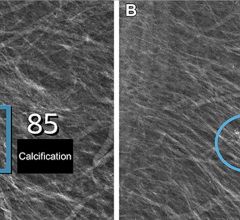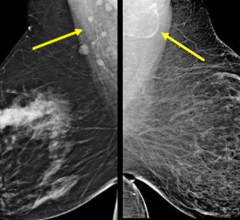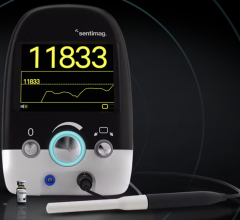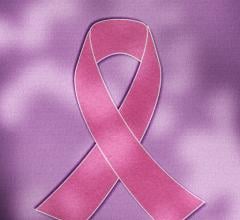
The funds for the new coach were donated by shoppers to CARRS/Safeway supermarket in just one month.
In Alaska, where the leading cause of death is cancer, access to the latest medical care and technology can mean the difference between life and death.
“The key to saving lives is early detection,” said Denise Farleigh, M.D., medical director of Providence Imaging Center, an independent diagnostic imaging facility in Anchorage, AK. “The greatest challenge in Alaska is access.”
The area’s need for better access led the Imaging Center to institute their first mobile mammography screenings back in 1989, using a cargo van equipped with a Hologic Lorad Transpo unit.
The old unit, unfortunately, had begun to show its years. “It had simply run out its design life,” said Dr. Farleigh. “Our mobile unit has always been very important to us, but there were some clients and sites that we had to stop visiting simply because we could not get the unit on the road.”
A Generous Gift
The Providence Imaging Center knew that if they were going to continue providing screenings to the women in Anchorage and the outlying areas, they were going to have to replace the mobile unit. Funds had been earmarked for the purchase of a new vehicle; it would be equipped with an older screen-film Lorad system (the Center had recently upgraded their mammography equipment with the installation of three Hologic Selenia digital mammography systems).
Thanks to the Providence Alaska Foundation (PAF), a local nonprofit group, and the generous support of the CARR’s/Safeway supermarket chain, the entire cost for a new mobile unit was donated to the Imaging Center. The donation allowed the Center to use their funds, originally intended for a new van, to purchase a new Selenia system for the mobile unit, thus ensuring that patients visiting the mobile van will receive the same quality mammograms as the women who visit the Imaging Center in Anchorage.
Equipped with the new Selenia and R2 Computer-Aided Detection (CAD) system, the new mobile van is a 33-foot self contained mammography suite, which can be driven to a site and parked. The women simply walk right in to get their exams.
Scheduled Runs, Trips to Remote Areas
For most of the year, the majority of the screenings performed by the mobile unit are located right around the Anchorage area. On average, the unit is out on the road about one day a week. When the van is out, it makes scheduled stops at several local medical centers that are not equipped for mammography and area businesses. The mobile unit also makes scheduled visits to area schools so that teachers can be screened.
“About every other month we send the van on an overnight trip,” said Susan Kessler, RT (R)(CV)(M)(QM)(CRT), the lead technologist for the mobile unit. The mobile unit is a one person operation; the technologist is responsible for imaging the patients as well as driving the van over the road.
“We schedule the van for the really big trips in the spring and fall. We go as far as Talkeetna, up near Denali National Park — Anchorage to Talkeetna is about a two and a half hour drive. And, we go out to Eagle River, about an hour’s drive away. The longest trips are to Valdez and Cordova. These areas require a six-hour ferry ride to access,” Kessler said.
During a recent trip out to Valdez/Cordova, over 200 women received screening mammograms.
Overcoming Alaska’s Greatest Challenge - Access
“Some women have never had screenings before,” Kessler said, “or if they did, they did not have them regularly, because getting to Anchorage is a huge deal for many of them. It’s a long trip, and if the system was not brought out to them, they would skip their exams.
“Some of these women live way out, in small cabins, some of them don’t have running water. It’s a huge effort to get to Anchorage to get an exam and yet, because of this unit, these women can get the latest in breast imaging technology,” Kessler said.
In addition, through a combination of state and private programs that provide breast and cervical cancer screenings to the working poor, the mobile unit of Providence Imaging Center can see women who are uninsured and in danger of falling through the cracks.
“We visit sites where we see almost exclusively this kind of population,” explained Kessler. “One day, a woman who had been living in a homeless shelter came in for her screening mammogram. She would not have been able to get one if it had not been for this unit. All day, every day, patients always tell me, ‘Thank you so much for bringing this here… I might not have been able to get [a mammogram] if I had to make the trip alone.”
“In an underserved population, you will always see a significant number of cancers in the unscreened that you would not have found if the unit had not been able to make its way out there,” Dr. Farleigh pointed out.
Unusual Challenges
Naturally, operating a traveling mammography unit in the northern most state in the union has its challenges. Because of the extreme weather conditions often found in Alaska, the unit must be protected from the elements at all times; if the Selenia were to get too cold, the layer of selenium coating the detector plate could possibly separate and peel off. The van is equipped with two on-board diesel generators to protect the Selenia system’s digital detector.
Thanks to the new mobile mammography van, the Imaging Center can once again return to the sites and locations that the old unit had forced them to discontinue serving. “Now that we have the new system…our goal is to have the unit out and running five days a week, year round,” said Kessler.
For the women of the Anchorage area, that’s very good news.



 July 29, 2024
July 29, 2024 








